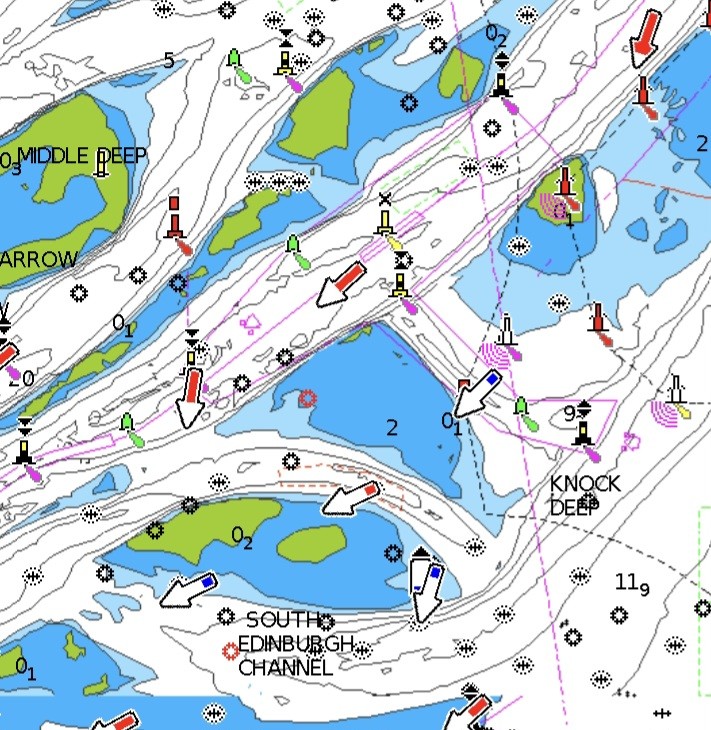Tiredness is dangerous at sea, and it creeps up faster as we grow older, so we need to think hard about how best to avoid it. Having good equipment is obviously vital, but top of my list of priorities is not hardware but changing our attitude to the challenges of weather and sea. We must take the lazy option, and stay where we are if it looks too much like hard work out there.
Continue reading “Lazy sailing for oldies”Tag: Navionics
RYA navigators still last in the fleet
Sometimes I wonder where the Royal Yachting Association has been for the last 10 years. I have just had an email from them saying “in the next ten years or so digital will become the dominant method of navigation”. In the real world of small boats, digital has been the dominant method of navigation for at least the last 10 years.
Continue reading “RYA navigators still last in the fleet”Is your chart relying on an 1860 survey?
Footnote to cruising the Scillies: piloting there is a reminder of the importance of proper Admiralty charts, because they show the age of the surveys on which they are based, unlike any of the proprietary ‘vector’ charts available on chartplotters.
The Scillies is a mixed area from this point of view. Some of the surveys of the area were last done in 1860 – 1904 by lead line, probably from boats carried on naval survey ships and rowed up and down in straight lines quite a long way apart, so rocks could easily be missed. Other parts of the islands were surveyed at a range of different dates in the 20th century. Continue reading “Is your chart relying on an 1860 survey?”
Chart errors (contd).
Several earlier posts covered inaccuracies in charts. Last week I came across yet another example in Cala de Portinax, a bay at the north end of Ibiza in the Balearics. This screen shot from my Navionics chart shows depths in a fair amount of detail: yet the numbers were wrong by a factor of three or four.  Because of the modest depths shown, we motored in with great trepidation in Olivia Jane, a Beneteau 43 with a 2 metre draft. Yet we found the depths in the middle of the bay were all in the 11-13 metre range and even close in to the rocky shore we anchored in 8 metres. In contrast, the C-Map chart on the cockpit plotter gave no depths at all inside the bay, which is a safer option than mistaken information. We’ve fed this back to Navionics and await a reply, but the nagging question will always remain in future, even if this proves to be a rare mistake: can we trust the inshore information on these charts? What if the mistake had been the other way, showing 11 metres when only 2 metres was there? Do other brands of charts have similar errors? Continue reading “Chart errors (contd).”
Because of the modest depths shown, we motored in with great trepidation in Olivia Jane, a Beneteau 43 with a 2 metre draft. Yet we found the depths in the middle of the bay were all in the 11-13 metre range and even close in to the rocky shore we anchored in 8 metres. In contrast, the C-Map chart on the cockpit plotter gave no depths at all inside the bay, which is a safer option than mistaken information. We’ve fed this back to Navionics and await a reply, but the nagging question will always remain in future, even if this proves to be a rare mistake: can we trust the inshore information on these charts? What if the mistake had been the other way, showing 11 metres when only 2 metres was there? Do other brands of charts have similar errors? Continue reading “Chart errors (contd).”
How to mimic big ship equipment
To cut back seriously on paper charts, the greater vulnerability of equipment on a small craft to accidental damage would have to be taken into account, including lightning strikes. For small boats it is already possible to buy, at a price, extremely robust electronic systems, including waterproof laptops that withstand impacts (costing several thousand pounds), and high capacity lithium battery back-up packs; small back-up generators have also become cheaper in recent years and can be accommodated on many mid-sized cruising yachts.
At a cost, robust weather and shockproof electronic navigation with reliable backup systems should therefore be quite close to achievable now on a yacht. Even if we fall well short of the rigorous standards of an ECDIS system, we will not be carrying 100,000 tonnes of crude oil or thousands of containers, so perhaps we can be allowed to be rather less tough on the backup specifications. Similarly with training: new courses may be necessary, but perhaps not the 40 hours plus specified for ECDIS for commercial ship deck officers.
Continue reading “How to mimic big ship equipment”
Paper-free chart tables
The idea of a paperless chart table is usually dismissed out of hand, and the very suggestion makes some old hands fume. But if a 100,000 ton bulk carrier can now be paperless, then it is hard to maintain that it will always be a mad idea for experienced yacht owners.

